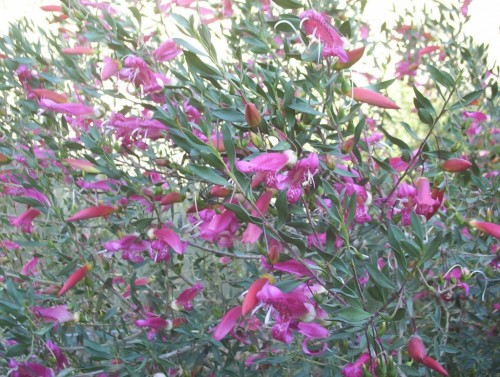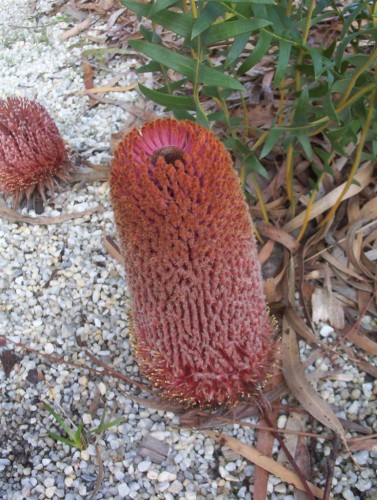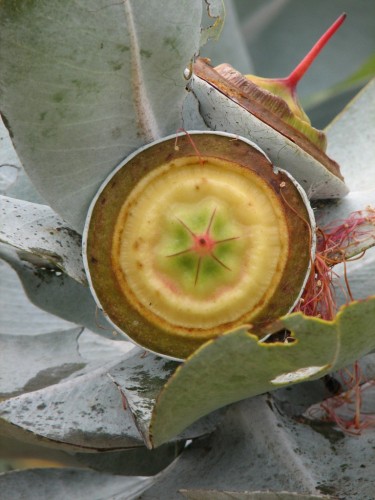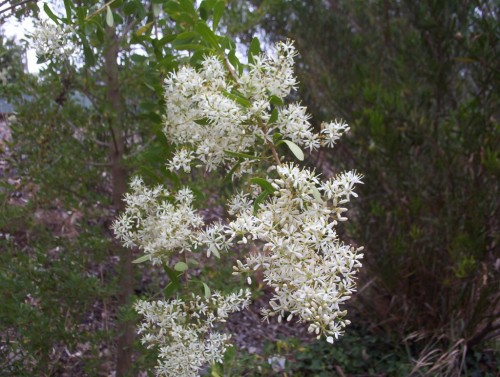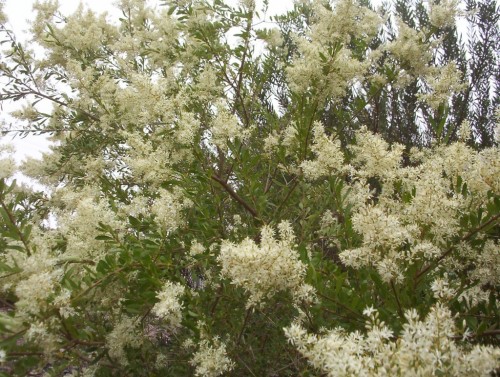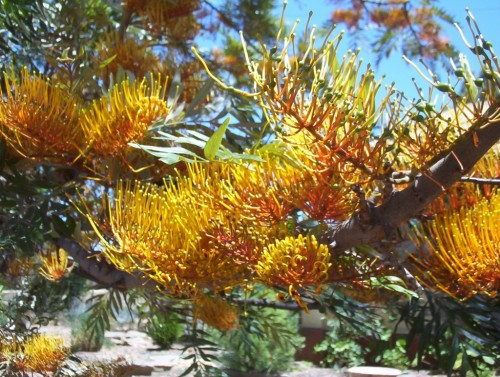Eremophila maculata forms (Emu Bush)
The Eremophila Study Group News Letter arrived and we are being encouraged to spread the good word about Eremophilas as hardy plants.
Plant hardiness is a relative term, I think. On the gardening programme Gardening Australia on ABC TV, the term is used by presenters in the Eastern States. A plant is described as hardy there, when I know that it is not hardy here unless it is regularly watered during the summer. A writer in the ‘Journal’, magazine of the Australian Plants Society, South Australia, prefers to refer to plants as being ‘adaptable’ or not. I tend to agree with him. There are many plants which would come into that category.
However, Eremophilas tend to be both hardy and adaptable. The issue that bothers many plants is over watering. Especially plants in pots. Watering regularly on a weekly basis as our water restrictions impose on us will spell disaster for many native plants, especially those that have a form of summer dormancy. Another issue is drainage which must be very good for Eremophilas.
The photo above is a selection of Eremophila maculata ‘Wendy’ which has reddish buds which open to dark pink. Tip pruning and trimming produces a bushy plant and many flowers.
Banksia blechnifolia
This photo was taken at the entrance to Cranbourne Botanic Gardens. The soil is quite sandy and reflects the main need for all Banksias and that is very good drainage. This can be achieved by planting in a raised bed. I have read that the top of the planting hole only needs to be 4-6 inches (10-20cm) above the surrounding ground level to achieve the drainage required. The plant grows 2-4m wide and about 50cm high.
This is an adaptable drought hardy plant originating in Western Australia, north of Esperence. It will tolerate dappled shade through to full sun. It withstands light to moderate frosts.
Eucalyptus macrocarpa (Mottlecah)
This beautiful shrubby tree has been the subject of some comments on an earlier article that I wrote. I responded to one reader who asked about the life span and hardiness of the tree…
“I can tell you from experience that Eucalyptus macrocarpa is a long lived plant. One that I know, at the end of a school playground, continues even now after 25+ years of being trampled, swung in, climbed through, footballs thrown in etc. Another near where I live is about 23 years old. These are mallee plants ie, shoot from the base when broken or cut or burnt, and have multiple stems. They need good drainage and airflow around them otherwise they tend to suffer from sooty mould. Eucalyptus macrocarpa is well worth trying for the flower display. It would make good large pot plants if you cannot give it the conditions that is needed.â€
Another reader’s comment would interest Australian plant growers.
From Ron…”I have grown Eucalyptus macrocarpa in my garden for more than 20 years. They seem to thrive on the hot/dry summers we have here in Escondido, CA. (We only average about 12 inches (300mm) of rainfall a year and recently we haven’t even seen that. Our rainy season in in the fall and winter.)
I rarely ever water the plants and they are very adapted to drought once established. My trees (very shrubby, multibranched, 12ft.(4metres) high) are absolutely beautiful. Although the oldest of my 3 trees is a little more than 20 years old, I know of several in San Diego (about 20 minutes from my house) that are more than 35 years old and I suspect thay live a lot longer than that.
So they have a very long lifespan.”
The conditions sound like mine here except that we are experiencing drought at the moment and have no subsoil moisture. Even the native plants are struggling. (The photo above shows some sooty mould on the leaves.)
More on this plant here.
Bursaria spinosa (Christmas Bush)
I remember as a child picking armfuls of the branches to take home and arrange in a big vase to place in the open fire place which of course was not in use during the summer. The trouble was that ants love the plants which drip with nectar when in full bloom.
Grevillea robusta
These make good windbreak and screening plants. Many are grown in house yards but as they can be rather large need to be kept away from the house. A general rule is that the tree needs to be as far from the house as the tree’s ultimate height.
Grevillea robusta is the plant onto which other species of grevillea are grafted.
